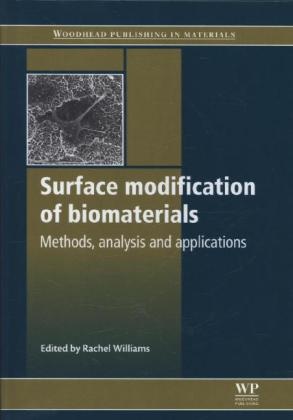Read more
Klappentext Surface modification of biomaterials plays a significant role in determining the outcome of biological-material interactions. With the appropriate modification a material’s surface can be tailored to improve biocompatibility, adhesion and cell interactions. Consequently surface modification is vital in the development and design of new biomaterials and medical devices. "Surface Modification of Biomaterials" provides readers with a comprehensive guide to the most pertinent surface modification techniques and technologies. Part one covers chemical surface modification methods whilst part two discusses topography and analysis methods. The final section of the book examines applications of this important technology. Inhaltsverzeichnis Part 1 Surface modification techniques: Surface modification of biomaterials by plasma polymerisation; Surface modification of biomaterials by covalent binding of poly(ethylene glycol) (PEG); Surface modification of biomaterials by heparinisation to improve blood compatibility; Surface modification of biomaterials by peptide functionalisation; Metal surface oxidation and surface interactions; Surface modification of biomaterials by calcium phosphate deposition; Biomaterial surface topography to control cellular response: Technologies, cell behaviour and biomedical applications. Part 2 Analytical techniques and applications: Techniques for analysing biomaterial surface chemistry; Techniques for analysing biomaterial surface structure, morphology and topography; Modifying biomaterial surfaces to optimise interactions with blood; Modifying biomaterials surfaces with bioactives to control infection; Modifying biomaterial surfaces to optimise interactions with soft tissues; Modifying biomaterial surfaces for the repair and regeneration of nerve cells; Modifying biomaterial surfaces to control stem cell growth and differentiation; Modifying biomaterial surfaces to optimise interactions with bone.
List of contents
Part 1 Surface modification techniques: Surface modification of biomaterials by plasma polymerisation; Surface modification of biomaterials by covalent binding of poly(ethylene glycol) (PEG); Surface modification of biomaterials by heparinisation to improve blood compatibility; Surface modification of biomaterials by peptide functionalisation; Metal surface oxidation and surface interactions; Surface modification of biomaterials by calcium phosphate deposition; Biomaterial surface topography to control cellular response: Technologies, cell behaviour and biomedical applications. Part 2 Analytical techniques and applications: Techniques for analysing biomaterial surface chemistry; Techniques for analysing biomaterial surface structure, morphology and topography; Modifying biomaterial surfaces to optimise interactions with blood; Modifying biomaterials surfaces with bioactives to control infection; Modifying biomaterial surfaces to optimise interactions with soft tissues; Modifying biomaterial surfaces for the repair and regeneration of nerve cells; Modifying biomaterial surfaces to control stem cell growth and differentiation; Modifying biomaterial surfaces to optimise interactions with bone.

